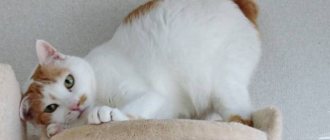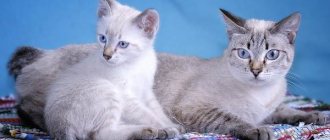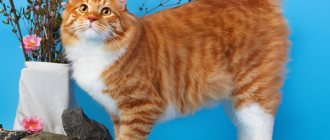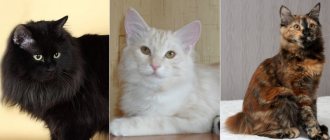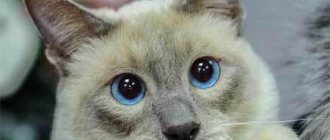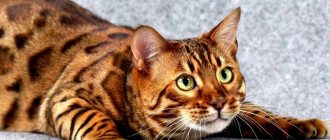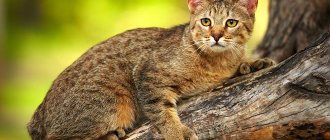When hearing the word “bobtail,” many people associate it with a dog. We tend to think that this is the name of the breed, although this term is used to refer to bobtail. And not only dogs, but also cats have this body structure. In any case, the Japanese Bobtail is one of the famous cat breeds, the representatives of which are distinguished by a short tail.
These cute creatures came to us from distant Japan and today live in the homes of many cat lovers. Easy care and playful character are advantages that any owner will definitely appreciate.
Origin story
The first information about the breed can be found in Japanese sources. But since Japan is an island nation that has been isolated for a long time, it is difficult to trace the historical path of cats as reliably as possible. However, it is known that people first started talking about the breed in 530-540. ad. This is how cats came to Japan from ships that were engaged in trade. Most likely, these were Asian merchants, since the country was actively trading with China and Macau at that time.
The Japanese were afraid of ordinary cats with normal tails and for a long time did not dare to have them in their homes. They believed that there was an evil force in the animal's tail. Therefore, in the XIX-XX centuries. Cats born in Japan went to local surgeons, who cut off these appendages, believing that this way they could get rid of evil. It is believed that this physical abuse caused a gene mutation, and the animals were immediately born tailless.
But everything changed during the reign of Emperor Ichijo. He brought a Japanese bobtail into his palace - the cat received the status of a maid of honor and even wore a beautiful collar. Then the Japanese also decided to tame such cats. By the way, it is believed that bobtails used to have tails, although not as long as other breeds.
Until the middle of the 19th century. Japan was in political isolation, which is why the bobtail did not reach other countries. But when the country opened its borders, short-tailed pets aroused considerable interest from foreigners. In 1968, one of the breeders, Elizabeth Freret, brought the first representative of this breed to Western Asia, and then American Lynn Beck brought the kittens to the USA and founded a club dedicated to the breed.
In 1990, the Japanese Bobtail was officially recognized by breed and show associations around the world.
Education and physical activity
The Japanese are smart but stubborn cats. If owners can interest their short-tailed pets in the training process, they will show impressive results.
Japanese cats are endowed with an incredibly active temperament and cannot sit for long without moving. They especially love to engage in fetching and catching imaginary flies. So that the agile and jumping Japanese can splash out their accumulated energy, they are equipped with a sports corner with ladders and multi-level platforms.
Description of the Japanese Bobtail: standard, characteristics
According to international standards, a purebred kitten must have the following characteristics:
- the average weight of an adult is 2.5-3 kg (cat) and 4-5 kg (cat);
- the head is long, slightly similar in shape to a triangle with equal sides, the muzzle is rounded at the bottom;
- large eyes, wary gaze;
- the eyes are located slightly at an angle;
- wide set of ears that stand straight, turned closer to the center of the head;
- long and slender body with clear geometry and a straight back;
- a long and even nose with two parallel stripes from the tip to the eyebrows;
- the paws are high and proportional, the front ones are shorter than the hind ones, but are located at an angle in the shape of the letter Z;
- The bobtail's tail can be curved, straight, pom-pom-like, or curled, but the difference between the Japanese bobtail is that it is very short;
- maximum tail length – 12 cm;
- The coat is of medium length, slightly thicker in the tail area, and there is no undercoat.
This description is typical for purebred cats. There are mixed species, and it is important to exclude them when choosing if in the future you plan to send the animal to an exhibition or organize a nursery.
How to choose the right kitten
Japanese Bobtail kittens are considered very rare and cost a lot of money. In order not to become a victim of deception and not to buy a mixed breed, it is better to look for an animal in specialized nurseries that are registered in the international felinological system. At the time of concluding the transaction, the little Japanese must have documents confirming his breed and vaccinations.
When choosing a kitten, it is recommended to evaluate it in terms of compliance with standards. And the most important characteristic that you need to pay attention to is the length and configuration of the tail. This is precisely the main breed characteristic of the Japanese.
Important! The “short-tail gene” is dominant in Japanese Bobtails. Therefore, a pair of purebred cats cannot give birth to a kitten with a regular tail.
You should also pay attention to external signs that indirectly indicate the health status of the little Japanese. He should not have a bloated belly, bald spots on his coat, scratches on his skin, dirt under his tail or in his ears.
Kitten care
Since there are relatively few nurseries that breed Japanese bobtails, kittens have to be booked in advance. Potential owners have plenty of time to thoroughly prepare for the arrival of the short-tailed baby. They buy everything necessary for his care. This set includes:
- bowls for food and water;
- bed or house;
- toys;
- tray and filler;
- grooming tools;
- hygienic cosmetics.
To protect the curious Japanese from accidental injuries, breakable objects, indoor plants, household chemicals and wires are removed from the house in advance. Also, the bobtail kitten is limited in access to large equipment, open windows and open balconies.
Coloring Features
The Japanese Bobtail is distinguished by a faded color compared to the same Thai Bobtail, which has a contrasting coat. But cats of bright colors are also found in this breed, although less often. They are considered the most valuable. There are several color options:
- tricolor or mi-kay;
- fiery red;
- snow-white;
- black.
The eyes of a cat most often have a slight yellow tint, while in an animal with a white color they are blue. But sometimes animals are born with different colored eyes. This is especially true for snow-white kittens.
This variety is always worth higher than the standard options, because such an individual will always produce kittens with different eyes.
Breeding
Since the breed is difficult to access in Russia due to the small number of nurseries, it is difficult to find individuals for breeding. Japanese bobtails are of interest to an increasing number of Russians, but it is difficult to find a purebred Japanese rarity in our country.
You can note the basic rules. Since the breed is not whimsical, it has no concessions in its range. But it should be remembered that it is still worth carrying out selection in order to obtain purebred offspring that will not only vaguely resemble a Japanese figure.
Important! If you cross a Japanese Bobtail with another breed, the offspring will have a standard tail.
The call to mating in this breed is not accompanied by heart-rending screams. Instead they make trouble. It is also worth noting that the bobtail itself is an excellent and caring mother.
3-4 kittens are born in one litter, the mortality rate of which is very low. When crossing a Japanese Bobtail with a long-tailed breed, offspring with a long tail are born.
Character
The Japanese Bobtail, like a true samurai, has an explosive and warlike character. Such cats are good hunters and are ready to hunt down small rodents, birds, and insects for hours. They constantly demand attention and try to move more often. They definitely need daily walks and games.
It is important to immediately train bobtails strictly, because they quickly acquire bad habits and are difficult to get rid of them. But they have friendly relations with family members. Children especially love bobtails, and they reciprocate. However, household members may be allergic to wool - it is important to rule out this fact before purchasing an animal.
If there are other pets in the house, it is important that they do not have the same explosive temperament. For example, it is difficult for a bobtail and a ferret to get along. They either quarrel or create a “gang” and act out in the absence of their owners. They do not like to sit on laps and do not tolerate being held in arms, because these creatures are independent and do not like it when their freedom is encroached upon.
Bobtails are inquisitive and easy to train. Therefore, it is important to immediately instill in them norms of behavior that will not interfere with the comfortable life of the owners. Also, from excess energy, a cat can scratch the wallpaper or tear a pillow to shreds. To avoid this, you need to pay attention to the animal - it does not like to be alone.
Lifestyle
Even at age, the Japanese Bobtail does not look like a lazy person. A leisurely walk from the sofa to the bowl and back is not his style. Centuries spent in continuous hunting take their toll. While in the apartment, they perceive it as a hunting ground. Therefore, walks in nature are necessary for the animal. When walking with a bobtail, you should remember that the Japanese in the old days kept them on a leash, and do the same.
There is one important aspect in the life of purebred bobtails - exhibitions. Participation in show rings is a test for animals and their owners. Future champions from a very early age should be raised to be sociable and not timid.
You should always take care of the health and vaccination of cats. This is especially important for exhibition participants. Omissions in this matter reduce the chances of winning to zero. An unvaccinated animal or an animal with signs of disease is not allowed to participate in the event. In addition to sick cats, pregnant and lactating cats usually do not participate in the exhibition.
A natural change in an animal's body is molting. In this state, the animal's chances of winning are minimal. A cat that is actively shedding can produce an unhealthy appearance. For these reasons, owners do not exhibit their dogs in show rings during the molting period.
Mobile and active bobtails are accustomed to calm behavior in crowded and noisy places. At a young age, they are taken to show rings for one purpose - they must calmly endure exhibition conditions.
Cats-competitors, in addition, do not have the right to be aggressive towards the hands of others. They are touched, examined, felt. The Japanese Bobtail cat is subjected to palpation in the most delicate places.
Mr. Cat recommends: Japanese Bobtail in art
People who are fond of watching anime know that the Japanese bobtail is often found in the frames of such cartoons. Moreover, it was this breed that became the prototype for the creation of the famous souvenir “maneki-neko” - a figurine in the form of a cat waving its paw.
This decoration for your home or office attracts good luck if the cat’s right paw is moving, or money if the cat’s left one is active. Often the Japanese themselves buy and give such souvenirs to company owners, and in stores this figurine stands in the most visible place so that they can earn good money.
These cats are often depicted on souvenirs or even product packaging, because the animal is beloved by the Japanese and encourages local residents to buy the product.
Maintenance of the Japanese Bobtail: nutrition
You can use artificial or natural food. The latter must include:
- sea fish;
- low fat beef;
- dairy products;
- liver and other offal.
Taking vitamin complexes is mandatory. You will also need to monitor your weight. It is better to stick to the norm of 80 kcal per 1 kg of body weight. Although representatives of this breed are generally not prone to obesity due to constant activity (with the exception of castration and sterilization).
Among brands of artificial food, premium options are recommended - usually such manufacturers have a wide range of products, which allows you to choose an option depending on the age and other characteristics of the cat.
It is also necessary to constantly monitor the availability of water for the animal, because cats of this breed are active and often want to drink.
Care
Caring for a bobtail is very easy. They quickly adapt to life in an apartment or private house, characterized by an unpretentious disposition and minimal requirements for comfort. The only thing that needs to be provided to the animal is freedom of movement.
You can’t lock a cat in a room because he will start ruining things out of boredom.
Hygiene
Hygiene is simple:
- It is enough to thoroughly comb a short-haired pet once a week. For long-haired breeds, it is better to use a comb 2-3 times a week.
- Eyes and ears should only be cleaned when they become dirty. To do this, simply moisten a cotton pad with warm water or chamomile decoction.
- It is necessary to bathe the animal rarely so as not to disrupt the level of skin hydration. This can be done in case of severe contamination.
Health
The cat has no abnormalities other than a shortened tail. She has a strong immunity to other ailments, and with regular vaccinations and proper care, the animal will feel good. The tail also does not cause developmental abnormalities over time and does not cause disease.
Feeding the cat
Energetic and active Japanese people need a balanced diet that contains all the necessary vitamins and minerals.
Complete diet
Many breeders prefer to feed Japanese bobtails with premium or super premium dry food. It is good because it already contains all the necessary vitamins and microelements. The main thing is that it does not contain wheat, soy, dyes or other dubious additives. The following brands of food are optimally suited to these requirements:
- Hills;
- Arden Grange;
- Brit Care;
- Bosch.
With a natural type of nutrition, the diet of the Japanese Bobtail is designed so that meat predominates in it. The cat should also receive:
- porridge;
- offal;
- vegetables;
- eggs;
- sour milk;
- ocean fish.
To avoid problems with the digestive system and health in general, the Japanese Bobtail should not be given sweets, pickles, smoked foods, sausages, pork and starchy vegetables. It is also forbidden to feed the cat river fish, fresh milk, exotic fruits and any leftovers from the owner’s table.
Feeding frequency
Little Japanese eat less, but more often than adult representatives of the breed. Therefore, when drawing up a feeding schedule, you need to focus on the age of the cat:
- up to 16 weeks – 6 times a day;
- 4-5 months – 5 times a day;
- 5-9 months – 4 times a day;
- 9-12 months – 3 times a day.
A one-year-old Japanese bobtail is fed twice a day.
Vitamins and minerals
When feeding natural products, a cat’s body may lack certain microelements. To compensate for this deficiency, the Japanese Bobtail is given vitamin complexes twice a year in courses.
Important! Before introducing mineral supplements into the Japanese diet, you should consult a veterinarian.
Interesting Facts
Close relatives of Japanese bobtails live in the Kuril Islands, in the area of Iturup and Sakhalin. Only their popularity increased in the 90s. last century. Cats from this area belong to the Kurilian Bobtail breed.
They have long hair and also a strange tail shape. A fur coat of wool reliably protects from the cold, and on the front paws there are even downy “pants” that cats inherited from their Siberian ancestors.
Cost of Japanese Bobtail
Sales are usually conducted through nurseries. Upon purchase, the owner receives all the documents, and the employees will talk about the intricacies of caring for the animal and show photos of the parents. Kittens living in nurseries are usually already vaccinated.
As for the cost, in Russia animals are valued at 15-35 thousand rubles for a pet-class pet. Kittens for breeding and exhibitions are more expensive. Unique kittens with different colored eyes cost up to 70 thousand. Abroad, the price of bobtails is 500-600 dollars.
Despite their ease of care and easy-going nature, bobtails require not only attention from the owner, but also a clear understanding that the animal needs to be looked after. Proper upbringing, a balanced diet and the creation of comfortable living conditions in the house - all this will help the Japanese Bobtail to remain cheerful and give a good mood to the owner.
Photo gallery of Japanese bobtails:
1111
Bobtail dog
Under the shaggy coat of this dog lies a wayward, cheerful animal with persistence and innate herding instincts. The Old English Sheepdog or Bobtail loves people and is a good watchdog, although it is not a guard dog. The dog requires decent attention, especially in matters of grooming.
The first thing that catches your eye when meeting a bobtail dog is its amazing coat. Previously, these dogs were unreasonably considered stupid. In fact, the bobtail is an independent and intelligent animal. From an ordinary herding dog, the Old English Sheepdog has turned into an excellent companion dog that can help on the farm and brighten up the loneliness of any person. This is a very good-natured and active dog.
Many people describe the Old English Sheepdog as a kind, loyal pet that adores people. At the same time, sometimes the dog is distinguished by its stubbornness. Let's look at the main points that those who decide to become a bobtail owner need to know. The Old English Sheepdog has a fairly loud voice, but it is not a guard breed. Bobtail will be a great friend for children. He gets attached to people. To keep such a dog, you need to fence the yard with a high fence. Very often, shepherd dogs easily jump over small fences.
Early socialization of the dog is essential. This is of key importance in education and will prevent mistrust and aggression towards strangers. Some experts advise purchasing Old English Sheepdog puppies from breeders who raise puppies in their own homes. This is due to the fact that from birth the animal is among people and gets used to the appropriate atmosphere.
After purchasing a puppy, it is best to send it to a special class for training, but first consult with your veterinarian. Training from a professional will guarantee proper and effective education and training. The need for early training is primarily due to the fact that at this age puppies are completely controllable and make excellent contact. During training, you should reward your dog with praise and favorite treats. The most important thing in training an animal is patience and consistency.
Quite often the Old English Sheepdog is compared to a yard dog. The reason for this is her active behavior. The herding instincts inherent in this breed are the reason for the animal's activity. That is why the surrounding area should be securely fenced. This does not mean that the pet should be kept outside. When the family is at home, the dog should be with you. Lack of attention towards your pet can cause aggression and stress.
The distinctive feature of any Old English Sheepdog is its coat. This is also the most difficult part of caring for a dog. The thick and long coat will require weekly brushing from the owner, so be prepared to spend half an hour to an hour weekly. If you want your bobtail to take part in exhibitions, then the coat requires daily care! The disadvantage of this breed is
possible wool on carpets and furniture, however, with sufficient care such troubles can be avoided.
How much does a bobtail puppy cost?
Bobtail price:
- minimum price: $800.00
- maximum price: $1200.00
- average price: $1088.89
